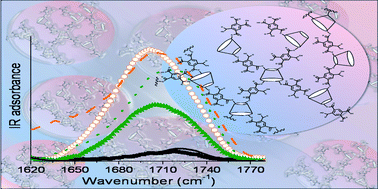Modelling the interplay between covalent and physical interactions in cyclodextrin-based hydrogel: effect of water confinement
Abstract
The vibrational dynamics of a new class of ![[double bond, length as m-dash]](https://www.rsc.org/images/entities/char_e001.gif) O stretching bands assigned to the
O stretching bands assigned to the

Maintenance work is planned for Wednesday 1st May 2024 from 9:00am to 11:00am (BST).
During this time, the performance of our website may be affected - searches may run slowly and some pages may be temporarily unavailable. If this happens, please try refreshing your web browser or try waiting two to three minutes before trying again.
We apologise for any inconvenience this might cause and thank you for your patience.
* Corresponding authors
a Dipartimento di Fisica e di Scienze della Terra, Università di Messina, Viale Ferdinando Stagno D'Alcontres 31, 98166 Messina, Italy
b
Department of Chemistry, Materials and Chemical Engineering “G. Natta”, Politecnico di Milano, Piazza Leonardo da Vinci 32, Milano, Italy
E-mail:
andrea.mele@polimi.it
Fax: +39 0223993180
Tel: +39 0223993006
c Dipartimento di Informatica, Università di Verona, Strada le Grazie 15, Verona, Italy
d
Dipartimento di Fisica, Università di Trento, via Sommarive 14, 38123 Povo, Trento, Italy
E-mail:
rossi@science.unitn.it
Fax: +390 461281690
Tel: +390 461282940
e Dipartimento di Chimica, Università di Torino, Via Pietro Giuria, 10125 Torino, Italy
The vibrational dynamics of a new class of ![[double bond, length as m-dash]](https://www.rsc.org/images/entities/char_e001.gif) O stretching bands assigned to the
O stretching bands assigned to the

 Please wait while we load your content...
Something went wrong. Try again?
Please wait while we load your content...
Something went wrong. Try again?
V. Crupi, D. Majolino, A. Mele, B. Rossi, F. Trotta and V. Venuti, Soft Matter, 2013, 9, 6457 DOI: 10.1039/C3SM50827G
To request permission to reproduce material from this article, please go to the Copyright Clearance Center request page.
If you are an author contributing to an RSC publication, you do not need to request permission provided correct acknowledgement is given.
If you are the author of this article, you do not need to request permission to reproduce figures and diagrams provided correct acknowledgement is given. If you want to reproduce the whole article in a third-party publication (excluding your thesis/dissertation for which permission is not required) please go to the Copyright Clearance Center request page.
Read more about how to correctly acknowledge RSC content.
 Fetching data from CrossRef.
Fetching data from CrossRef.
This may take some time to load.
Loading related content
